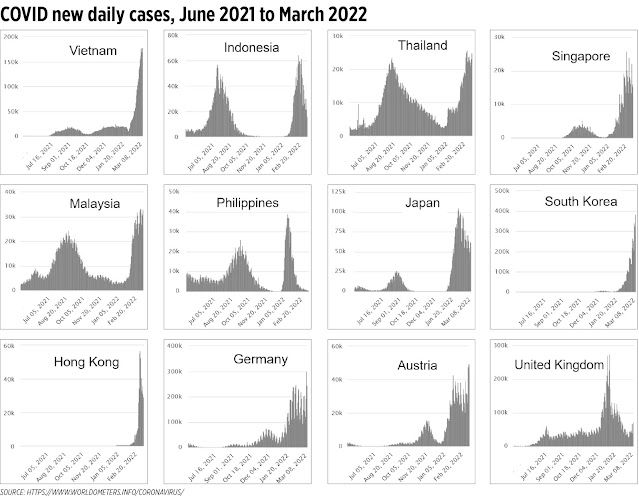BWorld, After two years of lockdown, what have we achieved?
------------
After two years of lockdown, what have we achieved?
This coming Wednesday, the Philippines will mark the second anniversary of the lockdown imposed by the government on March 16, 2020. It was supposed to be a temporary “two weeks only to flatten the curve” enhanced community quarantine (ECQ). The two weeks became two months of modified ECQ (MECQ), which became two years of ECQ, MECQ, general CQ (GCQ), modified GCQ (MGCQ), and Alert levels 1 to 5.
So, have we “flattened the curve” of COVID-19 cases and deaths in the Philippines and other countries? Or has the law of unintended consequences kicked in again?
Here are 10 observations and facts from the two years of lockdown.
One, the Philippine economy was flattened. It suffered the worst, deepest economic performance since post-WW2 with a 9.6% GDP contraction in 2020. Of the top 50 largest economies in the world by GDP size, the five worst performing economies in 2020 were Spain with -10.8%, followed by Argentina -9.9%, the UK -9.8%, the Philippines -9.6%, and Italy -8.9%.
A few economies managed to grow in 2020 because they did not impose heavy lockdowns on their people and businesses.
Two, in 2021 almost all countries managed to grow due to “base effect.” Their 2020 GDP levels were so low that any marginal increase above that low base would translate to growth. The Philippines grew 5.7% in 2021 but that would be equivalent only to the GDP level of 2018. It will reach the 2019 level around the second or third quarter of this year.
Three, the Philippines has had the worst, strictest lockdown policies in Asia and among the worst in the whole world in 2020. One measurement is the Google COVID-19 Community Mobility Reports (GCCMR), percent changes in mobility from the baseline period of Jan. 3 to Feb. 6, 2020 (pre-lockdowns worldwide). Two of six areas in the GCCMR are chosen: Retail and Recreation (restaurants, cafes, malls, museums, cinemas) and Transit stations (subway/MRT stations, seaport, taxi stand, highway rest stops, car rentals).
Economies that escaped contraction in 2020 like Taiwan and Vietnam had less strict lockdowns, like their mobility restrictions and change in transit stations were only -13% compared to the Philippines’ -60% (See Table 1).
Four, lockdowns or mandatory stay-at-home-unless-going-to-work-or-buy-necessities orders were proven to be ineffective in controlling the spread of the virus. This is shown by the prolonged, indefinite lockdowns, mild or strict in form, while COVID cases and deaths continued. In the Philippines, the total cases per million population at end-2020 of 4,269 increased five times by end-2021. Total deaths per million population end-2020 of 83 increased also five times by end-2021.
Five, the Philippines’ COVID cases per million of 33,000 as of March 10 this year are actually low compared to our neighbors in the ASEAN like Thailand, Vietnam, Malaysia, and Singapore. Also, lower than those that are richer and have better healthcare systems like Japan, South Korea, and Hong Kong.
Six, those Asian countries mentioned have higher vaccination rates than the Philippines. As of end-2021, the Philippines’ 45 fully-vaxxed people per hundred was nearly one-half (1/2) that of Singapore’s 85 and South Korea’s 83, yet these two countries have COVID cases per million that are three to four times larger than the Philippines (See Table 2).
Seven, vax discrimination worsened the lockdown policies in the Philippines — like no vax-card-or-negative-PCR-tests, no entry to offices, malls, or public transportation like buses, boats and planes. See again Table 1 — the Philippines’ -42% mobility change in transit stations in 2021, -25% in retail and recreation, was among the highest in the world.
Eight, the omicron variant seems to be the “natural vaccine” that affected millions of Filipinos within weeks but mostly with no or mild symptoms and allowed the body to develop natural immunity. The result was a rapid rise then rapid decline in the number of cases.
Nine, more vaccination, more COVID cases. Until last week, the Philippines had the lowest rate of fully-vaxxed people in Asia and yet the Philippines has had consistently declining COVID cases, and somehow attained natural herd immunity. In contrast, high vax rate countries Vietnam, Thailand, Malaysia, South Korea, etc. have high or rising number of cases as do some industrialized countries in Europe — Germany, the UK, and Austria. (See Covid new daily cases chart).
Ten, lockdown and implicit mandatory vaccination should stop. Vaccination should be voluntary, not mandatory. People own their body, not the government or the World Health Organization, or the media and medical NGOs. The economic damage of the lockdown has been severe over the past two years. This plus the high energy and consumer prices because of the economic sanctions against Russia and the continuing war in Ukraine mean people need to work more, produce more food and other physical commodities, and transport them across provinces, cities and islands.
The number of vax injuries and vax-related deaths is rising too. According to the Open VAERS (vaccine adverse events reporting system, https://openvaers.com/) as of March 4 there were more than two million reported cases, including more than 25,000 COVID vaccine reported deaths around the world, and these are just the voluntarily reported incidents, estimated to constitute just 1% of actual adverse events.
In the coming Presidential elections, voters should remember the “flatten the economy” impact of the two years of lockdown by the Duterte administration. The BBM-Sara Duterte tandem is the embodiment of continued economic hardships. They should not win.







Comments
Post a Comment